Poles liked Adolf Hitler, although it was a perverse and somewhat capricious sympathy. A bit shy too. It is true that the Chancellor was sometimes laughed at. It evoked a shiver of anxiety, and at the same time ... fascinated and inspired. Who and what?
Love begins with the head, and indeed, the only, undisputed head of interwar Poland - Józef Piłsudski - was Adolf Hitler clearly intrigued. As a good strategist and author of Polish foreign policy, he could not, however, afford an uncritical delight. He was aware that the militarization of Germany, the overtly aggressive nature of the Nazi groups, or the chief tendencies of the Chancellor himself lead easily to war.
The Marshal also knew very well about the anti-Polish moods prevailing in German society, neatly fueled by the prolonged customs war between the two countries, as well as the conflict over Gdańsk, which was exceptionally irritating to both sides. Besides, the mutual dislike between Poles and Germans was not a secret for anyone - diplomats from both countries spoke openly about it during more or less official meetings. Piłsudski's mistake was that he blamed it entirely on the old Prussian aristocracy - in Hitler he saw someone who would be able to invent Germany anew, without those old anti-Polish prejudices .
He knew the history of these negative relationships, and knew that they were by no means so deeply entrenched. Barely a hundred years earlier, insurgents going into exile, later called the Great, were welcomed in the Germanic countries by banners with the words:"Poland is not yet dead while Germany is alive". Perhaps Piłsudski counted on the fact that the rejuvenated German society, deprived of the Prussian drill, would restore that atmosphere.
A very characteristic case was noted by Minister Jan Szembek in his memoirs. Well, once called to the Belvedere Palace, he found the marshal completely absorbed and clearly moved by one of Hitler's Nazi appeals. According to Szembek, Piłsudski enthusiastically hit the desk several times with a document and announced in disbelief that "we hear the first such voice from a German mouth". Apparently, he was delighted with everything - of course also with radical anti-Bolshevism, on which both politicians were completely in agreement.
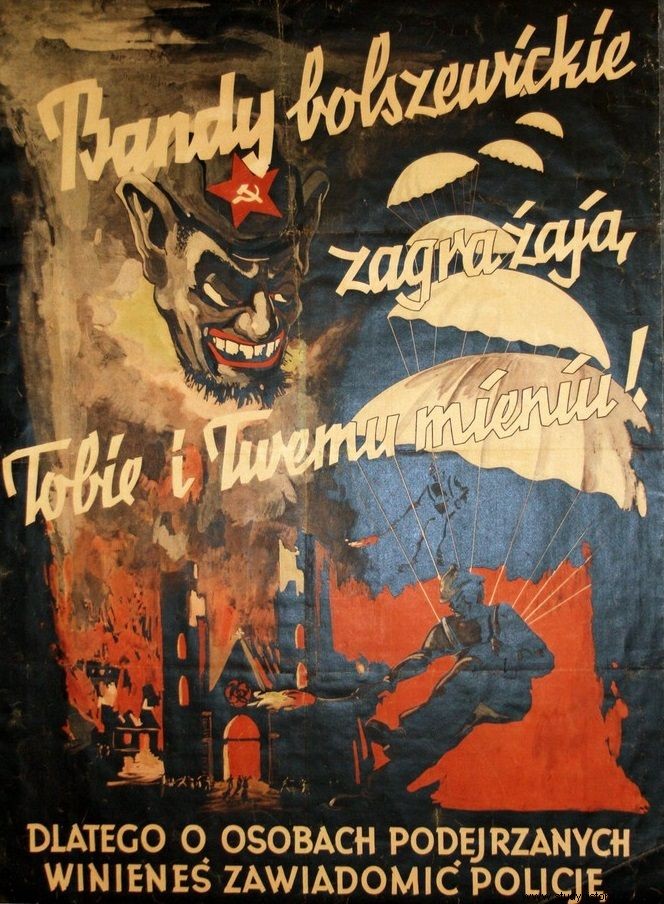
Although the mutual interests of Piłsudski and Hitler differed significantly, they were completely unanimous on the issue of anti-Bolshevism. Fragment of the Polish-language Nazi poster.
A nice dictatorship
Piłsudski was not a private person and his infatuation with the Fuhrer - fully reciprocated, by the way - did not end with personal emotions. He was followed by the sympathy of the fully controlled and freely censored media, and then - their readers . It is the example of Hitler's media assessments in the Polish press of the 1930s that it is best to see to what extent they were dependent or even controlled by the ruling camp.
As long as Hitler was recognized only as a political adventurer without any serious importance - the media, regardless of the political option, was clearly critical of him. "Gazeta Polska", associated with the Sanacja camp, saw in it, for example, "an ordinary politician pretending to be a prophet", who is usually a "poor prophet and a poor politician". The Jewish "Nasz Przegląd" wrote:
Hand raised up. Hoarse voice and… sorry to report. Words without panache, a strange average thought. Less effective phrases in the spirit of Goebbels .
In turn, the journalists of "ABC" found an analogy between him and Charlie Chaplin, but instead of a characteristic cane, with a thick club in his hand .
However, the situation changed from week to week - the closer Hitler was to power, and the more serious partner he became for Poland, the more reluctance gave way to admiration. At the end of January 1933 - when he assumed the office of chancellor - the nationalists from the "ABC" daily began to see him as a leader who could "set the masses on fire and carried away." They commented:
His pronunciation is so pure and clear that you hear every word in the farthest corner of the room. He underlines words, sentences with a gesture of his hand, throws them in front of him, like hand grenades. And his words ignite the crowd, because Hitler knows how to influence the psyche of the crowd.
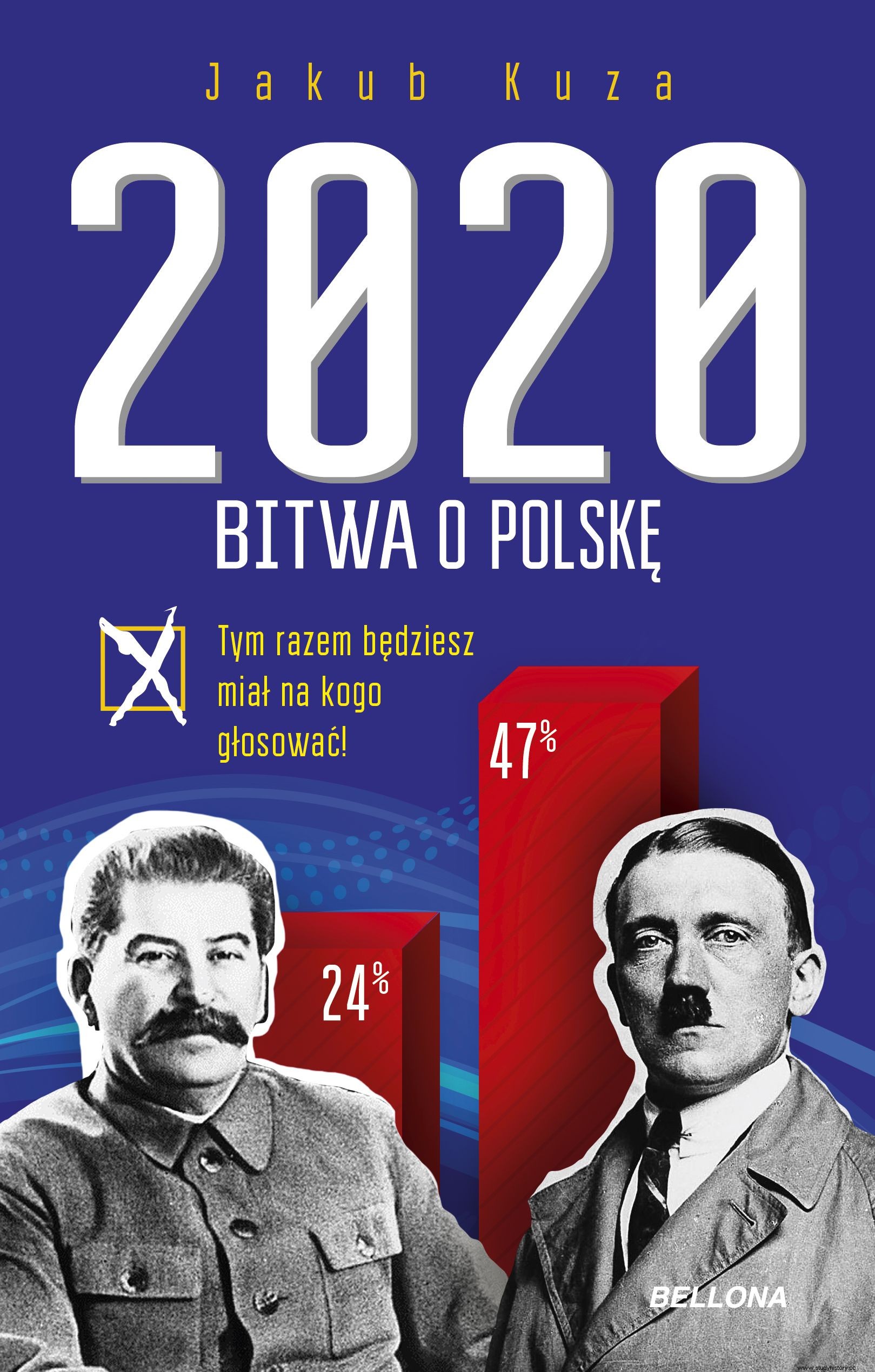
The latest book by Jakub Kuza " Battle for Poland 2020 "(Bellona 2018) is a provocative story about the future in which there are two candidates in the presidential election:Stalin and Hitler.
His consistency and persistence were also appreciated. It was noted that "failure does not break it that easily", because "otherwise, Hitlerism would have ended after the once unsuccessful coup in Munich". But it was not only the national press that began to appreciate Hitler, or at least to express himself respectfully - if still somewhat reserved - about him. The centrist "Gazeta Polska", which had been chasing him earlier, out of nowhere appreciated the Chancellor as an efficient orator "influencing the imagination of crowds with emotional effects".
Fed with this information, Poles liked Hitler. It is true that he was the protagonist of cabaret sketches, in which his gaudy style was parodied, and satirical drawings and caricatures circulated the streets ... All this, however, humanized him, warmed the figure of the chancellor and aroused favor, rather than disturbing him. Such an image of Hitler suited the ruling camp, because the "friendly dictatorship" was precisely the model that politicians consistently pursued, and which became indispensable after Piłsudski's imminent death. In official statements by politicians, Nazi Germany, just like fascist Italy, was described in no other way than as "dynamic states". And Poland also wanted to be dynamic .
Phalanges of colored shirts
The popularity of Adolf Hitler in the early 1930s in Poland is also quite well demonstrated by the fact that shortly after his coming to power, several weeks apart, spontaneously and completely independently of each other, several local National Socialist parties were established in different parts of the country. . It is true that they officially spoke out critically about Nazism, but at the same time almost one hundred percent duplicated both the organizational structure, uniforms, and ideological and economic slogans contained in the German program.
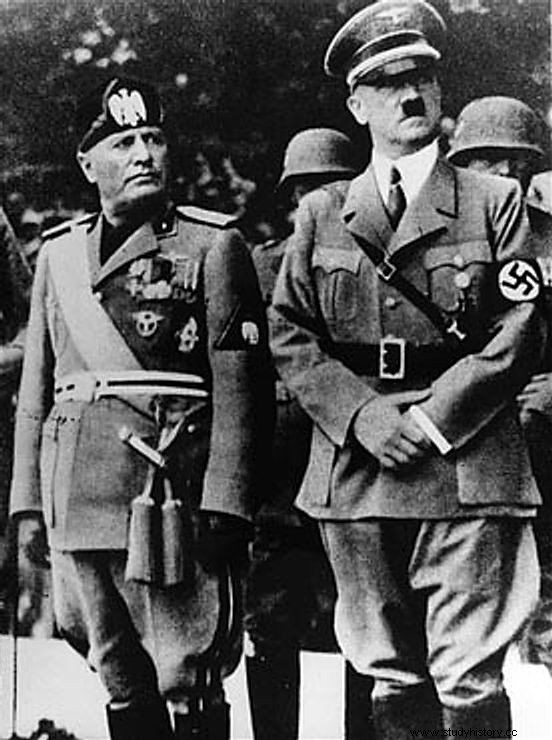
Both fascist Italy and Nazi Germany were for Poles in the interwar period a model of "dynamic states". Mussolini and Hitler are pictured.
The only difference was that the Germans talked about Great Germany, while the Poles spoke about the Great Slavic region. The Nazi pattern was obvious in this case. The swastika symbol was commonly used here - but it was stubbornly credited with the Slavic origin. They wore identical long military boots and uniform shirts - though not brown, but blue, green or cherry shirts. The main activity was marching with compact phalanxes; sometimes also beating up political opponents.
As in Germany, universal and fanatical anti-Semitism flourished in Polish national-socialist circles. " We do not hate Jews, because it can be done in relation to our equals, we abhor them like vermin "- gave a sample of the radical rhetoric of the time," Front of Poland Awakened ", published by the Silesian Radical Movement of Healing. Only Krakow's "Swastika" was a bit more reserved in this respect, the editors of which, however, first of all demanded that Poland return to the pre-partition borders - leaving the crackdown on Jewry for later.
All these organisms were identical even in terms of naming. The Radical Healing Movement was a surprisingly original exception in this regard. The rest of the National Socialist landscape was already made up of such formations as the National Socialist Party, the National Socialist Party, the National Socialist Workers Party and the National Socialist Party - to mention only the largest of them, although - in truth - the personal boundaries between they were never too spicy either. The historian Anna Landau-Czajka, who dealt with this subject, remarked, spreading her hands helplessly:
Sometimes it is extremely difficult to tell where one party ends and another begins, so even giving the exact number of extreme nationalist groups is difficult, if not impossible .
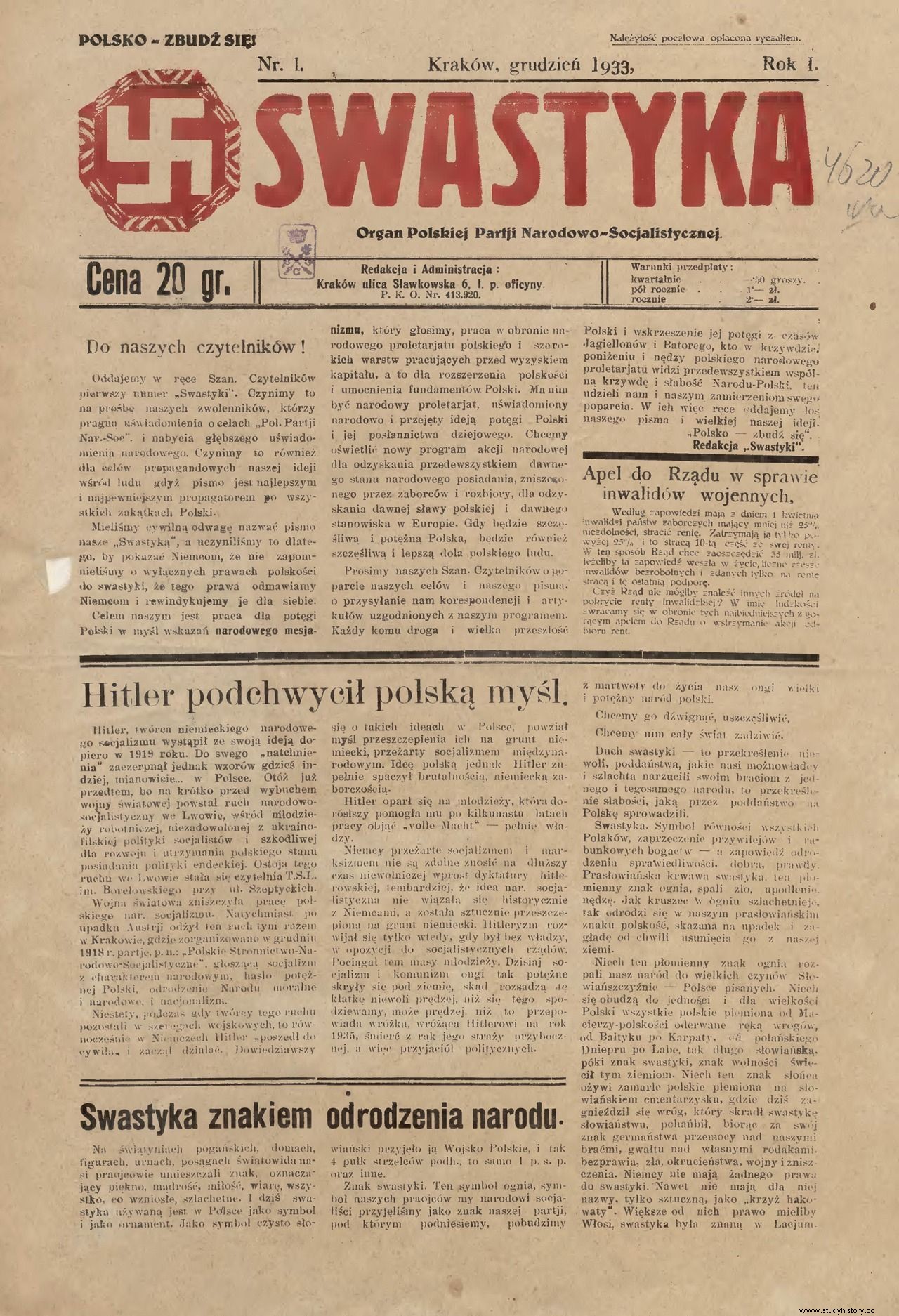
Polish National Socialist political parties often had their own writing organs. The illustration shows the first page of Krakow's "Swastika", which - contrary to its name - was one of the less radical magazines.
In view of all this program, personal and image identity, it is puzzling that these groups essentially fought each other. The Krakow Nazis, for example, described the journalism of their Silesian colleagues in no other way than "insane nonsense". On April 5, 1934, several dozen members of the Polish National Socialist Party marched into the general meeting of the National Socialist Workers' Party and a regular battle took place, as a result of which four people were badly mauled and one stabbed .
Nazism licensed by Lviv
Neither of these parties was mass, but neither were they forces whose presence could be taken lightly. They usually had several hundred active members, and their journalism was read by up to tens of thousands of people . For example, the magazine "National Socialist", published by the Party of National Socialists, was initially a monthly magazine, but after a few months, great interest resulted in it being published on a weekly basis.
The "Polish Charter", on the other hand, was the body of the National Socialist Party of Towns and Villages, established a little later - on the way of not entirely clear organizational divisions - had a circulation of 5,000 copies, but up to 25,000 people declared reading it. The importance of these parties can also be seen in the interest that the Sanacja authorities devoted to them. Only the police reports from the Archives of New Files in Warsaw clearly show that out of 50 of their members, at least five were informants of the services. As a real problem in their activities, the organizations also indicated the constant requisitioning of their writings by censorship, as well as progressive illegalisation - hardly any of these parties survived for more than 2-3 years.
So although this whole movement had virtually no real political significance, it turned out to be a litmus test confirming that national socialism, and even simply Nazism, was indeed mocked, downplayed and disregarded in Poland, but in fact only for its external manifestations :the caricaturality of the figure of Hitler itself, the aggressiveness of his enthusiasts, the ubiquitous militarism, or the tendency of the entire movement to totalitarianism and the leadership system of rulership. As a pure idea, it seemed attractive.
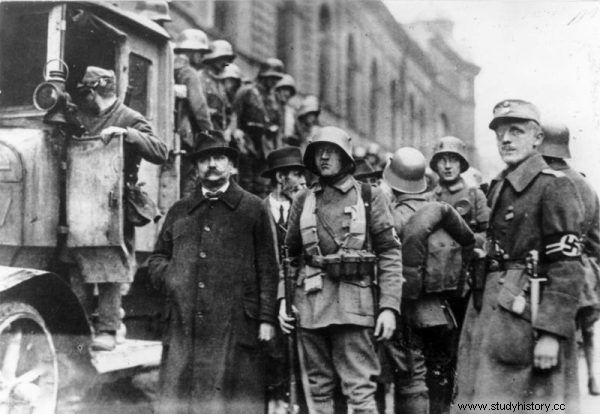
In Hitler, most saw the main ideologist of Nazism. Not Poles in the interwar period, who thought that the chancellor ... got lost from the Poles. The photo shows the Munich coup.
And so much so that in some circles it was even considered our original concept. In the "Swastyce" of December 1933, the article "Hitler picked up the Polish thought" was published, in which the authors, referring to a marginal group of Lviv nationalists from before the First World War, argued:
Hitler, the founder of German National Socialism, only came up with his idea in 1919. However, for his "inspiration" he drew patterns elsewhere, namely in ... Poland .
Can you imagine a bigger compliment?
***
If you think it couldn't be worse, Jakub Kuza in his latest novel " Battle for Poland 2020 ”(Bellona 2018) shows that the specter of the dictatorship lurks behind our backs. In the presidential race, there are unexpectedly two candidates that Poles would like to forget:Józef Stalin and Adolf Hitler.
A provocative, revealing book that tells us more about ourselves than about Hitler and Stalin:

